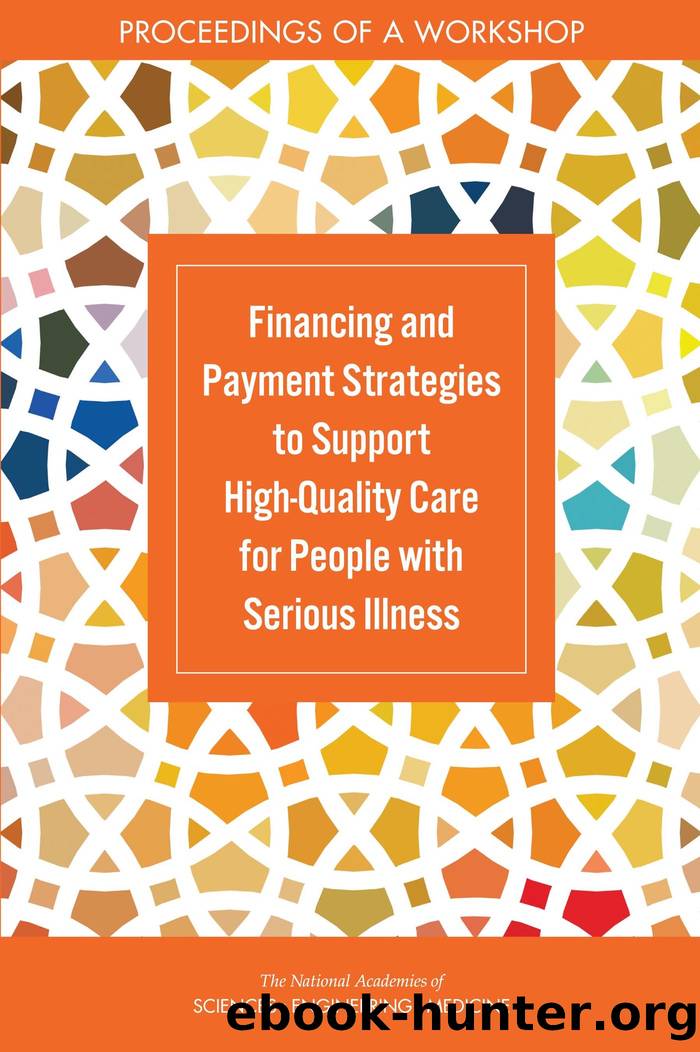Financing and Payment Strategies to Support High-Quality Care for People with Serious Illness: Proceedings of a Workshop by unknow

Author:unknow
Language: eng
Format: epub
Tags: Health and Medicine: Healthcare and Quality, Health and Medicine: Policy, Reviews and Evaluations
Publisher: The National Academies Press
Published: 2018-05-16T00:00:00+00:00
Discussion
After the second sessionâs presentations on financing and payment innovations, Paz opened the discussion by asking the panel what they would describe as the key outcome measures needed to define the quality of the serious illness programs and align that care with value-based reimbursement. Fine explained that because Baylor focuses on patient care planning, creating new advance directives, getting the appropriate changes and code statuses, decreasing the number of attempted, non-beneficial CPRs, and tracking symptom outcomes are very important, despite the variability across hospital campuses. Popiel then added that beyond those metrics, the alignment of the experience of the patients, their caregivers, and their families is also important. However, he noted, the quality of that experience is hard to quantify beyond a typical satisfaction score.
Teresa Lee of VNA Health Group pointed out that her organization is still learning lessons from their participation in the Medicare Care Choices Model and CPC Plus. She noted that although CPC Plus was not originally intended for home care medicine, clinicians are able to innovate because they âhave the funds up front [and are able] to make investmentsâ in innovative practices and quality measures. In working with the Medicare Care Choices Model, Lee noted that the programâs largest challenge was that payment was not sufficient to provide hospice and all curative treatments comprehensively.
Allison Silvers from the Center to Advance Palliative Care explained that her organization is working to ensure sufficient compensation for the time providers need to attend to the seriously ill. Silvers asked the panel whether there is additional work to be done in terms of investing in bringing the health system up to speed, enhancing the skills that providers need, and whether payers would pay for that training. Popiel responded that Cambiaâs work is only beginning to scratch the surface âin terms of education and supportâ for network providers, regardless of whether they are in a âvalue-based payment arrangement or [a] broader PPO [preferred provider organization] network.â He believes there is more to be done, and that the next steps should involve more intensive collaboration and training. Debono agreed, explaining that Anthem âenvision[s] a situation in which [the clinicians, staff, and practice] are participating in some sort of value-based payment model and the payer participates in training the practice.â Chirico posited that âthat methodology [may not] be any better with an insurance-backed concept of education because of the expertise.â Ling responded, âpractices are learning to redesign themselvesâ and that the Transforming Clinical Practice Initiative,23 as an example, is helping to understand the costs and to inform the services that need to be delivered.
Becky Shipp of the Sheridan Group wondered from the âview [of] the field, are these programs working?â To give context, she explained that there are many state-based programs, but many are not available in every state. Dr. Ling explained that the programs have provided access to services, but that the challenge is to determine consistent measures, such as quality, in order to evaluate these programs in a rigorous fashion. She then
Download
This site does not store any files on its server. We only index and link to content provided by other sites. Please contact the content providers to delete copyright contents if any and email us, we'll remove relevant links or contents immediately.
Good by S. Walden(2925)
The Social Psychology of Inequality by Unknown(2320)
0041152001443424520 .pdf by Unknown(2231)
The Checklist Manifesto by Atul Gawande(2211)
The Meaning of the Library by unknow(2079)
23:27 by H. L. Roberts(1896)
Guns, Germs and Steel by Diamond Jared(1894)
Being Mortal: Medicine and What Matters in the End by Atul Gawande(1812)
Borders by unknow(1792)
A Leg to Stand On by Oliver Sacks(1717)
The Hot Zone by Richard Preston(1643)
And the Band Played On by Randy Shilts(1625)
The Valachi Papers by Peter Maas(1521)
The Obesity Epidemic by Robyn Toomath(1429)
The Laws of Medicine by Siddhartha Mukherjee(1420)
The Andromeda Strain by Michael Crichton(1370)
The Plague and I by Betty Macdonald(1270)
Pharmacy Practice and The Law by Richard Abood(1259)
Autism's False Prophets by Paul A. Offit(1246)
